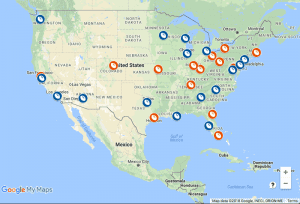Russia`s intervention in Crimea in 2014 led to harsh condemnation by NATO states and the creation of a new “spearhead force” of 5,000 troops on bases in Estonia, Lithuania, Latvia, Poland, Romania and Bulgaria. [25] At the ensuing summit in Wales in 2014, NATO leaders formally committed for the first time to devote at least 2% of their gross domestic product to defence by 2024, which was previously only an informal guideline. [26] NATO has not condemned the purges in Turkey from 2016 to the present day. [27] NATO members opposed the UN Treaty on the Prohibition of Nuclear Weapons, a binding agreement for negotiations on the complete elimination of nuclear weapons supported by more than 120 countries. [28] The new members of the Alliance came mainly from Central and Eastern Europe, including former members of the Warsaw Pact. Membership in the Alliance is governed by individual action plans and requires the consent of each current member. NATO currently has a candidate country for membership of the Alliance: Bosnia and Herzegovina. It helps potential members prepare for membership and meet important requirements by providing practical advice and targeted support. After the fall of the Berlin Wall in Germany in 1989, the organization carried out its first military interventions in Bosnia from 1992 to 1995 and later in Yugoslavia in 1999 during the disintegration of Yugoslavia. [19] Politically, the organization sought to improve its relations with the former Warsaw Pact countries, most of which joined the alliance in 1999 and 2004. Article 5 of the North Atlantic Treaty, which required Member States to assist any Member State exposed to armed attacks, was invoked for the first and only time after the attacks of 11 September[20], according to which troops were deployed in Afghanistan as part of the NATO-led ISAF. Since then, the organisation has carried out a number of additional tasks, including sending trainers to Iraq, assisting with counter-piracy operations[21] and, in 2011, applying a no-fly zone over Libya in accordance with UN Security Council Resolution 1973. The less powerful Article 4, which refers only to consultations among NATO members, has been invoked five times following incidents in the Iraq war, the Syrian civil war and the annexation of Crimea.
[22] Between 1994 and 1997, more comprehensive forums for regional cooperation between NATO and its neighbours were established, such as the Partnership for Peace, the Mediterranean Dialogue Initiative and the Euro-Atlantic Partnership Council. In 1998, the NATO-Russia Permanent Joint Council was established. Between 1999 and 2020, NATO included the following Central and Eastern European countries, including several former communist states: the Czech Republic, Hungary, Poland, Bulgaria, Estonia, Latvia, Lithuania, Romania, Slovakia, Slovenia, Albania, Croatia, Montenegro and North Macedonia. [18] All NATO agencies and organisations are integrated into either the civil administration or the military executive. .


